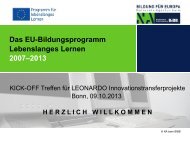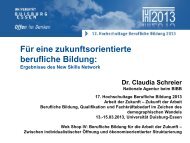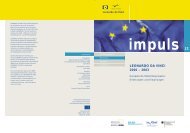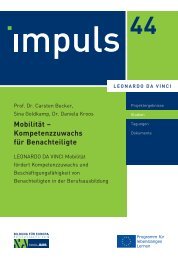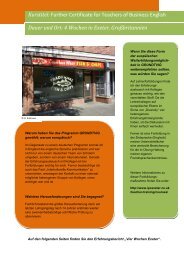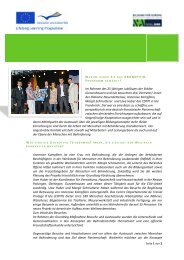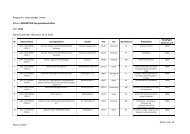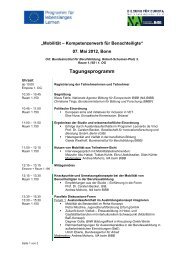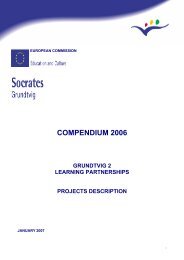Create successful ePaper yourself
Turn your PDF publications into a flip-book with our unique Google optimized e-Paper software.
Network's life<br />
employment. In many ways the labour<br />
market is the driving force that is bringing<br />
the VET and higher education systems<br />
together. Given the current employment<br />
situation, there is an increasingly important<br />
role for employers and their organisations<br />
to shape the type and style of<br />
learning and training that they need.<br />
However delegates also highlighted<br />
some of the practical constraints which<br />
can inhibit the use of units in both the<br />
higher education and VET sectors, e.g.:<br />
• training providers often prefer to train<br />
or teach large groups of learners in<br />
order to achieve economies of scale.<br />
Offering too much choice for learners,<br />
in terms of units, can make<br />
the training provision uneconomic. A<br />
similar constraint operates for workbased<br />
learning where employers can<br />
struggle to offer training which covers<br />
the full range of units;<br />
• sophisticated and sometimes expensive<br />
systems need to be established in<br />
order for learners’ achievements to be<br />
validated and recognised, and used<br />
to inform subsequent learning. For<br />
training organisations (including higher<br />
education), the accreditation of prior<br />
learning can be technical, time-consuming<br />
and subject to learners’ appeals;<br />
• validating and recognising achievements<br />
from units provided by the<br />
informal or non-formal sector can<br />
create problems for those who award<br />
qualifications. For awarding organisations<br />
to have confidence in the learning<br />
outcomes from these units, they<br />
often require extensive quality assurance<br />
processes to be in place;<br />
06 ECVET magazine n°12 / December 2012<br />
• the development and approval of units<br />
takes time and a considerable investment<br />
from stakeholders. If units are<br />
optional, their take-up is uncertain and<br />
the effort involved in their design and<br />
quality assurance may not be justified;<br />
• if units are too specialised, learners<br />
may not gain the breadth of skills and<br />
competences they need for a career<br />
in a sector e.g. a unit which specialises<br />
in hygiene in the ‘burger industry’<br />
may not provide as much breadth<br />
as a more generalised unit that covers<br />
hygiene in the catering industry.<br />
While some learners are very clear of<br />
their career intentions and are happy<br />
to specialise, others are less certain<br />
about their future.<br />
At the end of the seminar, participants<br />
sought to identify a way forward which<br />
built on what is common in the VET and<br />
higher education sectors – the EQF, the<br />
use of learning outcomes and credit,<br />
and a commitment to quality assurance<br />
as the basis for mutual trust. For some<br />
delegates recognising the differences<br />
between Vet and higher education was<br />
a necessary part of mutual learning and<br />
making progress. Developing greater<br />
alignment between the two sectors<br />
would only occur if individual institu-<br />
tions and each sector could see advantages<br />
for themselves. In many ways<br />
this was a ‘bottom-up’ approach rather<br />
than a ‘top-down’ approach which was<br />
promoted and led by the European<br />
networks.<br />
Each of the European instruments<br />
is well on its way to embracing units<br />
based on learning outcomes. However,<br />
there was recognition that this knowledge<br />
of units was not widely shared by<br />
VET providers, employers and learners.<br />
More needed to be done to share this<br />
knowledge which would help to quicken<br />
the pace of implementing the use of<br />
units based on learning outcomes.<br />
The forthcoming priorities should include<br />
the need to:<br />
• publicise, in simple language, the<br />
benefits of using units to design qualifications;<br />
• move beyond the piloting and testing<br />
phase of development in order<br />
that progression and mobility are perceived<br />
as everyday occurrences rather<br />
than unusual or rare events;<br />
• use the European instruments to identify<br />
the benefits of greater synergy and<br />
alignment for both the VET and higher<br />
education sectors.




